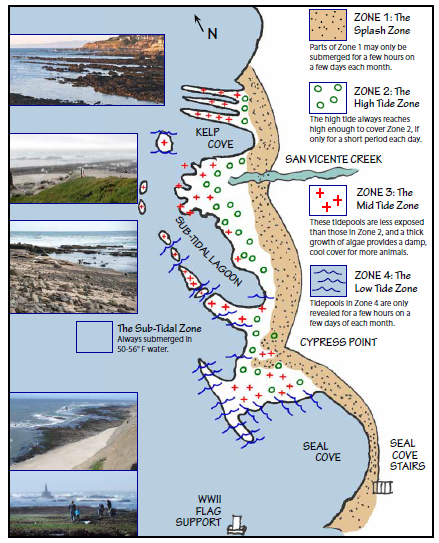Tides
Tides are complex and vary hour-to-hour, day-to-day, season-to-season. The rise and fall of the tides are caused by the gravitational pull of the moon and sun through the oceans.
At Fitzgerald, there are 2 low tides and 2 high tides per day. Daily tidal highs and lows will vary depending on weather conditions, time of year, phases of the moon.
The best time to explore the tidepools is when tides are predicted to be 1’ or less in height.
The KQED Quest website has a wonderful video explaining how the pull of the moon creates high and low tides, complete with an animation, and a great blog post with beautiful photos explaining the geology underlying the reserve.
Why visit during low tide?
To get the most out of a visit to the tidepools, plan to come during a low tide – the lowest low water level for a particular day. Low tides occur twice a day, but the lowest low tides tend to occur around the full moon and the new moon each month.
What if there’s “no suitable low tide” when you want to visit? What this means is that the tide pools are under water that is too deep to see the tidepool creatures, or that the low tide does not occur during daylight visiting hours, usually 8 a.m. – sunset, daily.
Zonation
Zonation refers to intertidal areas where, due to the amount of exposure to air, certain species and plants are adapted to the specific environmental conditions of that zone. At Fitzgerald, there are four zones: Splash, High Tide, Mid-tide and Low Tide. Click here to see the full version (PDF).

Splash zone
Splash Zone refers to the area of the tidepools that are exposed to the air 100% of the time. Many types of limpets live in the splash zone.

Photo: T. Niesen
High tide zone
This is the area which is exposed to air anywhere from 35% to 75% of the time. At Fitzgerald, this area is just below the cliffs or sandy beach.
The animals that live in this zone have adapted to living in areas that dry out between high and low tides.

Photo: T. Niesen

Photo: T. Niesen
Mid-tide Zone
This area is exposed to air from 35% to 7% of the time and is generally submerged except for a period during a low tide. This area comprises the majority of the rocky intertidal habitat at Fitzgerald.
The number of species that have adapted to living in the mid-tide zone include sulpins, sea stars and anemones.

Photo: T. Niesen

Photo: R. Cala

Photo: T. Niesen
Low Tide Zone
This area is exposed to the air from 7% to 0% of the time and may only be accessible to visitors for a few hours during the lowest, or minus, tides of the year.
Animals that live in this zone stay wet during the low tides and include brooding anemones, nudibranchs and chiton.

Photo: R. Cala

Photo: R. Cala

Photo: R. Cala
